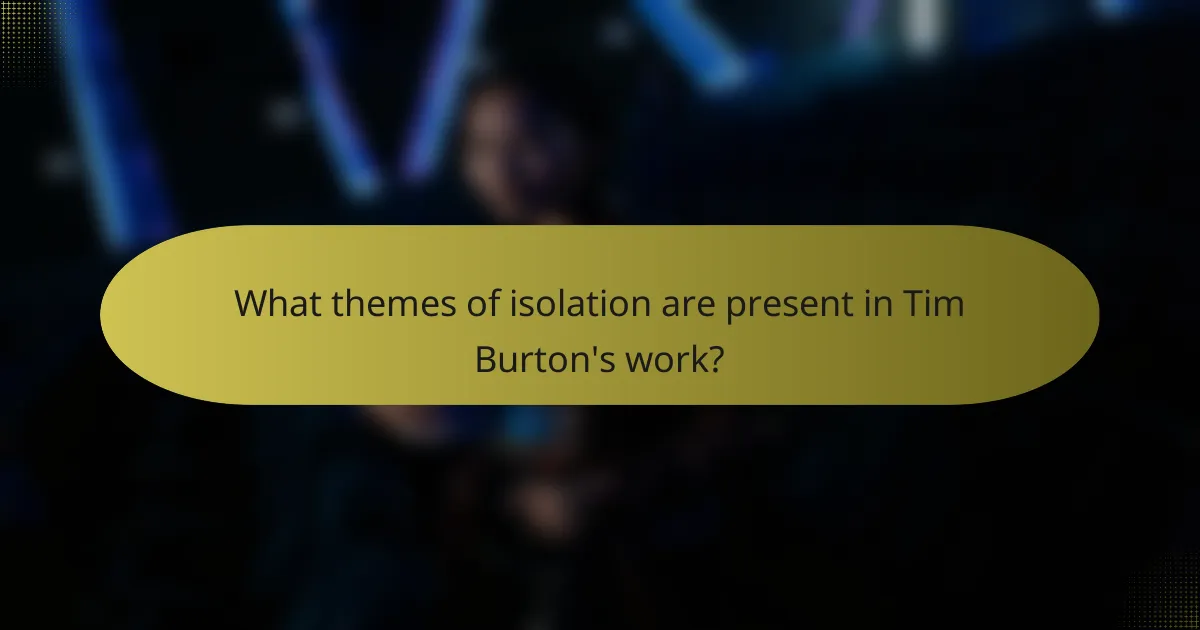Tim Burton is a filmmaker known for his distinctive style characterized by a whimsical yet dark aesthetic, which often blends gothic elements with quirky characters. His films explore themes of isolation and fantasy, frequently featuring protagonists who are outcasts or misunderstood individuals. Burton’s use of stop-motion animation and a unique color palette enhances the surreal worlds he creates, allowing for a captivating narrative experience. Iconic works such as “The Nightmare Before Christmas” and “Edward Scissorhands” exemplify his signature approach, highlighting the struggles of individuality within alienating environments. The combination of humor and horror in his storytelling resonates with audiences, making his films both memorable and impactful.

What defines Tim Burton’s unique style?
Tim Burton’s unique style is defined by its whimsical yet dark aesthetic. His films often feature gothic elements combined with quirky characters. Burton frequently employs a distinctive color palette, favoring stark contrasts. His storytelling explores themes of isolation and fantasy. The use of stop-motion animation is a hallmark of his work. Iconic films like “The Nightmare Before Christmas” showcase his signature style. Burton’s characters often embody outsider perspectives. The blend of humor and horror creates a captivating narrative experience.
How does visual aesthetics contribute to Tim Burton’s films?
Visual aesthetics play a crucial role in Tim Burton’s films. His distinctive style combines gothic elements with whimsical designs. This visual approach enhances the themes of isolation and fantasy. Burton often uses exaggerated proportions and surreal landscapes. These elements create a dreamlike atmosphere that captivates audiences. The color palette typically features dark hues contrasted with vibrant accents. This contrast emphasizes the emotional depth of the characters. Set designs often reflect a sense of otherworldliness, reinforcing the narrative’s fantastical elements. Overall, Burton’s visual aesthetics are integral to the storytelling in his films.
What are the key visual elements in Tim Burton’s work?
Tim Burton’s work features distinctive visual elements characterized by gothic aesthetics, whimsical designs, and exaggerated proportions. His films often showcase dark color palettes, primarily blacks, grays, and deep reds. Burton employs highly stylized characters with elongated limbs and oversized heads. The settings frequently include surreal landscapes that blend fantasy with macabre elements. Iconic motifs include spirals, stripes, and twisted trees, enhancing the dreamlike quality of his narratives. His use of stop-motion animation, particularly in films like “The Nightmare Before Christmas,” adds a unique texture to his storytelling. The combination of these elements creates a signature style that is instantly recognizable and deeply influential in contemporary cinema.
How does color palette influence the mood in his films?
The color palette in Tim Burton’s films significantly influences the mood. Burton often uses a combination of dark, muted colors and vibrant, contrasting hues. This contrast creates a sense of unease and whimsy simultaneously. For example, the use of stark blacks and grays against bright reds or greens heightens emotional tension. The color choices reflect themes of isolation and fantasy, enhancing the surreal atmosphere. Research by film theorist David Bordwell highlights how color can evoke specific emotional responses in viewers. This technique effectively immerses the audience in Burton’s unique narrative worlds.
What narrative techniques are prevalent in Burton’s storytelling?
Tim Burton’s storytelling employs several narrative techniques that enhance his unique style. One prevalent technique is the use of gothic imagery, which creates a distinct atmosphere. His characters often embody themes of isolation and alienation. Burton frequently utilizes non-linear storytelling to build suspense and maintain viewer engagement. Additionally, he incorporates whimsical elements juxtaposed with darker themes, creating a surreal contrast. His distinctive visual style often includes exaggerated proportions and vibrant colors to emphasize emotions. Dialogue in his works tends to be quirky and memorable, adding to character development. These techniques collectively contribute to the immersive quality of Burton’s narratives.
How does Burton use character development to convey themes?
Burton uses character development to convey themes of isolation and fantasy effectively. He creates complex characters who often feel alienated from society. These characters, such as Edward Scissorhands and Sally from The Nightmare Before Christmas, embody the struggle of being different. Their unique traits highlight their emotional depth and vulnerability. Through their journeys, Burton explores the impact of societal rejection. The development of these characters illustrates the longing for acceptance and belonging. This focus on character depth enhances the thematic resonance of isolation and fantasy in his works.
What role does dialogue play in his films?
Dialogue in Tim Burton’s films serves to enhance character development and convey thematic elements. It often reflects the quirky and eccentric nature of his characters. Burton’s dialogue is frequently laced with dark humor and whimsy. This style reinforces the themes of isolation and fantasy prevalent in his works. For example, in “Edward Scissorhands,” dialogue highlights Edward’s outsider status. The interactions between characters reveal their perceptions of normalcy and difference. Additionally, dialogue often contrasts the fantastical elements with mundane reality. This juxtaposition deepens the emotional impact of the narrative. Overall, dialogue plays a crucial role in shaping the unique atmosphere of Burton’s films.

What themes of isolation are present in Tim Burton’s work?
Tim Burton’s work often explores themes of isolation through his characters and settings. Many of his protagonists are outcasts or misunderstood individuals. For example, Edward Scissorhands embodies physical and emotional isolation due to his unique appearance. Burton commonly portrays suburban environments as stifling and alienating. This contrast highlights the isolation felt by characters who do not conform to societal norms.
Additionally, Burton’s use of gothic aesthetics emphasizes loneliness and separation. Films like “The Nightmare Before Christmas” depict characters in worlds that are disconnected from one another. The visual style reinforces feelings of estrangement. Overall, isolation in Burton’s work serves to critique societal norms and highlight the struggles of individuality.
How does isolation manifest in his characters?
Isolation in Tim Burton’s characters often manifests through their physical appearance, behavior, and social interactions. Many characters are depicted as eccentric or outcast figures. This visual representation emphasizes their alienation from society. For example, Edward Scissorhands is portrayed with scissor-like hands, symbolizing his inability to connect with others. His isolation is further highlighted by his reclusive upbringing. Similarly, characters like Jack Skellington feel disconnected from their environments and seek a sense of belonging. Burton’s settings often reflect this theme, featuring dark, whimsical landscapes that enhance the characters’ feelings of loneliness. Overall, isolation serves as a central theme in Burton’s storytelling, shaping character development and emotional depth.
What are some examples of isolated characters in Burton’s films?
Edward Scissorhands and Victor Frankenstein are examples of isolated characters in Burton’s films. Edward, from “Edward Scissorhands,” experiences isolation due to his unique appearance and inability to connect with others. Victor, in “Frankenweenie,” faces isolation as he is misunderstood for his scientific pursuits and love for his dog. Both characters embody themes of alienation and the struggle for acceptance. Their stories highlight Burton’s focus on the emotional depth of isolated individuals.
How do these characters reflect broader societal themes?
Tim Burton’s characters often reflect broader societal themes of isolation and acceptance. These characters frequently embody the struggles of being different in a conformist society. For example, Edward Scissorhands symbolizes the challenges of social integration due to his physical differences. His isolation highlights societal fears of the unknown and the consequences of ostracism. Similarly, characters like Sally from “The Nightmare Before Christmas” represent the quest for belonging amidst societal expectations. Their journeys emphasize the importance of self-acceptance and the need for community support. Overall, Burton’s characters serve as mirrors to societal issues, illustrating the complexities of identity and the human experience.
Why is isolation a recurring theme in his storytelling?
Isolation is a recurring theme in Tim Burton’s storytelling due to his focus on the outsider experience. His characters often embody feelings of alienation and loneliness. This reflects Burton’s own childhood experiences of feeling different and misunderstood. The visual style of his films enhances this theme, using stark contrasts and surreal landscapes. For example, in “Edward Scissorhands,” Edward’s unique appearance isolates him from society. Similarly, “The Nightmare Before Christmas” explores Jack Skellington’s existential crisis and longing for acceptance. Burton’s narratives often highlight the struggles of individuals against societal norms. This consistent portrayal resonates with audiences who identify with feelings of isolation.
What personal experiences may have influenced this theme?
Tim Burton’s unique style and themes of isolation and fantasy may have been influenced by his childhood experiences. Growing up in Burbank, California, he often felt like an outsider. His fascination with dark and fantastical elements stemmed from his experiences of feeling different from his peers. Burton was also influenced by his relationship with his parents, who supported his artistic pursuits. His early exposure to classic horror films and fairy tales shaped his visual storytelling. The blend of these experiences created a distinctive aesthetic in his work. His films reflect a deep understanding of isolation, often portraying characters who are misunderstood or marginalized. This connection to his personal history enriches the themes present in his storytelling.
How does isolation impact the narrative arc in his films?
Isolation significantly influences the narrative arc in Tim Burton’s films. It often serves as a catalyst for character development and plot progression. Characters frequently experience emotional and physical isolation, which shapes their journeys. This theme is prevalent in films like “Edward Scissorhands” and “The Nightmare Before Christmas.” In “Edward Scissorhands,” Edward’s isolation leads to his struggle for acceptance. His unique appearance and abilities alienate him from society. This conflict drives the narrative forward, highlighting themes of love and belonging. Similarly, in “The Nightmare Before Christmas,” Jack Skellington’s isolation from his own world prompts his quest for identity. His journey illustrates the consequences of feeling disconnected. Overall, isolation is a foundational element that deepens the emotional resonance and complexity of Burton’s storytelling.

How does fantasy play a role in Tim Burton’s films?
Fantasy is a central element in Tim Burton’s films. It shapes the visual aesthetics and narrative structures. Burton often blends whimsical elements with darker themes. His characters frequently inhabit surreal worlds that challenge reality. For example, “Edward Scissorhands” features a fantastical protagonist in a suburban setting. This contrast highlights themes of isolation and acceptance. Burton’s unique style includes exaggerated designs and vibrant colors. Such elements create an otherworldly atmosphere. His use of fantasy allows for exploration of complex emotions and societal issues. This approach resonates with audiences, making his films memorable and impactful.
What elements of fantasy are commonly found in his narratives?
Tim Burton’s narratives commonly feature whimsical characters, surreal landscapes, and dark humor. His stories often include elements of the macabre, blending fantasy with gothic aesthetics. Burton frequently utilizes exaggerated proportions in character design, creating a distinct visual style. Magic and the supernatural are prevalent, often driving the plot or character development. Themes of isolation and alienation recur, reflecting the struggles of misunderstood characters. His narratives also incorporate fairy tale motifs, reimagining classic stories in unique ways. These elements collectively contribute to the fantastical worlds Burton creates, engaging audiences with their originality and depth.
How does fantasy serve to enhance the storytelling in his films?
Fantasy enhances storytelling in Tim Burton’s films by creating surreal worlds that reflect characters’ inner struggles. These fantastical elements allow for deeper emotional exploration. For example, in “Edward Scissorhands,” the fantasy of a man with scissors for hands symbolizes isolation and societal rejection. The whimsical settings contrast with dark themes, emphasizing the characters’ loneliness. Burton’s use of exaggerated visuals captivates audiences and evokes empathy. The fantastical aspects often serve as metaphors for real-life issues, making the stories relatable. Ultimately, fantasy in Burton’s films enriches narratives by blending imagination with poignant commentary on human experiences.
What are some notable fantastical elements unique to Burton?
Tim Burton’s work features several notable fantastical elements. His films often include gothic aesthetics. These aesthetics are characterized by dark colors and whimsical designs. Burton frequently uses exaggerated character designs. Characters often have unique physical traits, such as elongated limbs or oversized heads.
Another element is the blending of the macabre with humor. This combination creates a distinctive tone in his storytelling. Burton also incorporates surreal landscapes. These landscapes often defy the laws of physics and reality.
Additionally, he utilizes stop-motion animation. This technique is evident in films like “The Nightmare Before Christmas.” Burton’s narratives often revolve around themes of isolation. Characters frequently experience feelings of alienation in fantastical settings.
These elements collectively define Burton’s unique style and contribute to his films’ enduring appeal.
How does Burton blend fantasy with themes of isolation?
Tim Burton blends fantasy with themes of isolation by creating whimsical yet dark worlds that reflect characters’ emotional detachment. His films often feature protagonists who feel alienated from society. For instance, Edward Scissorhands embodies this isolation through his unusual appearance and inability to connect with others. Burton’s use of exaggerated visuals enhances the sense of fantasy while highlighting the loneliness of his characters. The settings in films like “The Nightmare Before Christmas” are fantastical yet evoke feelings of estrangement. This combination allows audiences to empathize with characters who navigate both magical and isolating experiences.
What examples illustrate the interplay between fantasy and isolation?
Tim Burton’s works often illustrate the interplay between fantasy and isolation through various characters and narratives. In “Edward Scissorhands,” Edward embodies isolation due to his unique appearance and inability to connect with society. His fantastical abilities contrast sharply with the mundane suburban world, highlighting his loneliness.
In “The Nightmare Before Christmas,” Jack Skellington experiences isolation in his quest for identity. He becomes disillusioned with Halloween Town and seeks out the fantasy of Christmas Town. This journey reflects his desire to escape isolation through imagination.
“Corpse Bride” presents Victor, who feels isolated in his engagement. His encounter with the fantastical world of the dead allows him to confront his feelings of loneliness. These examples showcase how Burton intertwines fantasy and isolation, creating rich narratives that explore the human condition.
How does this blend affect audience perception of his films?
Tim Burton’s blend of unique style and themes of isolation and fantasy significantly shapes audience perception of his films. This combination creates a distinct visual aesthetic that is instantly recognizable. Audiences often perceive his films as whimsical yet dark, which sets them apart from mainstream cinema. The themes of isolation resonate with viewers, evoking empathy for characters who feel like outsiders. This emotional connection enhances the overall viewing experience. Burton’s artistic choices, such as exaggerated characters and surreal landscapes, reinforce this perception. The result is a loyal fan base that appreciates his unique storytelling approach. Thus, this blend not only defines his films but also influences how audiences relate to and interpret them.
What practical insights can be drawn from Tim Burton’s style and themes?
Tim Burton’s style and themes emphasize individuality and the beauty of the unconventional. His work often showcases characters who feel isolated or misunderstood, reflecting a deep connection to the theme of alienation. This highlights the importance of embracing one’s uniqueness. Burton’s use of gothic aesthetics and whimsical storytelling encourages creativity and imagination. His films often reveal that embracing one’s quirks can lead to personal growth and acceptance. For instance, “Edward Scissorhands” illustrates how societal norms can marginalize those who are different. Overall, Burton’s work serves as a reminder to celebrate diversity and find beauty in the unusual.
Tim Burton is the primary entity of this article, known for his unique style characterized by a whimsical yet dark aesthetic. The article explores key aspects of Burton’s work, including his distinctive visual elements, color palettes, and narrative techniques that highlight themes of isolation and fantasy. It discusses how his characters often embody feelings of alienation and how these themes are reflected in the surreal landscapes and gothic aesthetics present in his films. Additionally, the article examines the interplay between fantasy and isolation, providing practical insights into the significance of individuality and acceptance in Burton’s storytelling.